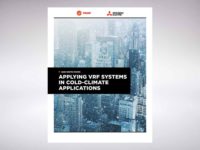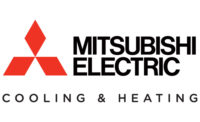Variable refrigerant flow (VRF) technology consolidates heating and cooling into one, all-electric system. Improving on the direct-expansion (DX) principle, a VRF system uses linear expansion valves (LEV) and an INVERTER-driven compressor to cycle refrigerant and transfer heat between its outdoor unit and the indoor unit(s) in each zone.
Continuous communication between the system’s outdoor units, indoor units, sensors, and controls allow VRF systems to modulate capacity based on loads and occupancy. With precise management of capacity, VRF systems reliably maintain each zone’s set point without the noisy and energy-intensive start/stop cycles of conventional systems. When in heating mode, the outdoor unit introduces heat drawn from ambient air or a nearby water source. When in cooling mode, the indoor units act as evaporators and send heat to the outdoor unit, where it’s rejected. If the VRF system is equipped with a branch circuit controller, it can also provide simultaneous heating and cooling by using heat recovery to transfer heat from zones requiring cooling to zones requiring heat. Heat-recovery systems are typically installed in buildings with multiple zones and diverse thermal profiles, such as office buildings, hotels, and multifamily applications. VRF heat pump systems are used for single-zone applications or multi-zone applications, where each zone has the same thermal profile.
Learn more in this white paper, presented by Mitsubishi Electric Trane HVAC US.



